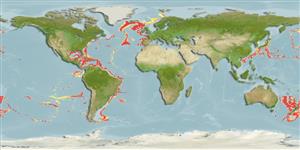Pycnogonida |
Pantopoda |
Colossendeidae
Environment: milieu / climate zone / depth range / distribution range
Ecology
Benthic; depth range 730 - 2200 m (Ref. 1797). Temperate
Atlantic and Pacific Oceans.
Length at first maturity / Size / Weight / Age
Maturity: Lm ? range ? - ? cm
Size intermediate among species. Proboscis longer than trunk, robust, conspicuously down curved over its entire length (rather than only distally). Palp segments moderately short, fifth less than half length of third, seventh next-longest, followed by eighth, tenth, sixth, and ninth which is shortest (other than two very short basal segments). Palp distal two segments recurved posteriorly toward trunk. Oviger terminal claw only as long as terminal segment diameter. Leg distal segments quite short in relation to long legs. Tarsus slightly shorter than propodus, claw less than propodal length (Ref. 9).
Abyssal (Ref. 169).
Life cycle and mating behavior
Maturity | Reproduction | Spawning | Eggs | Fecundity | Larvae
Members of the class Pycnogonida are gonochoric and sexually dimorphic. During copulation, male usually suspends itself beneath the female. Fertilization occurs as the eggs leave the female's ovigers. Males brood the egg masses until they hatch. Life cycle: Eggs hatch into protonymphon larva then to adults.
Child, C.A. 1998 The marine fauna of New Zealand: Pycnogonida (sea spiders). NIWA Biodiversity Memoire 109. National Institute of Water and Atmospheric Research (NIWA). Washington, D.C. 20530, USA. 71 p. + Figure 2A-G, 3A-F, 4, 5. (Ref. 9)
IUCN Red List Status
(Ref. 130435: Version 2025-1)
CITES status (Ref. 108899)
Not Evaluated
Not Evaluated
Threat to humans
Human uses
| FishSource |
Tools
More information
Trophic EcologyFood items (preys)
Diet composition
Food consumption
Predators
Population dynamicsGrowth
Max. ages / sizes
Length-weight rel.
Length-length rel.
Length-frequencies
Mass conversion
Abundance
Life cycleReproductionMaturityFecunditySpawningEggsEgg developmentLarvae PhysiologyOxygen consumption
Human RelatedStamps, coins, misc.
Internet sources
Estimates based on models
Preferred temperature
(Ref.
115969): 2.5 - 6.5, mean 4.3 (based on 748 cells).
Price category
Unknown.
